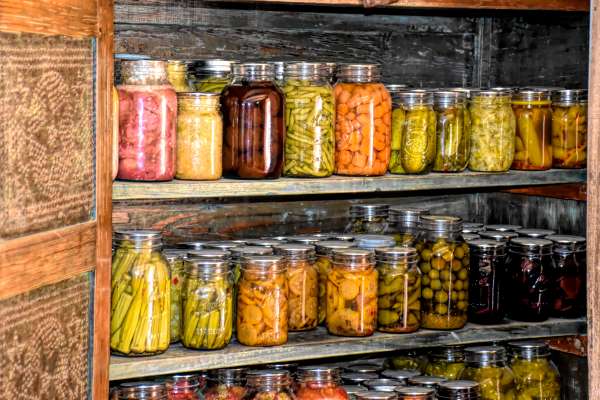We waste about 108 billion pounds of food each year. This food could have gone to hungry families and ended up in landfills instead. Once it breaks down, greenhouse gasses are released, contributing to climate change. Preserving food can help prevent these issues and save you a trip to the store. So, here are a few tricks for keeping your leftovers fresh.
1. Cold Storage Methods
This involves storing food in refrigerators within cool, dark places like root cellars. A root cellar is built underground and is insulated. This cooling method slows down the growth of micrograms that cause items to spoil.
Add produce such as potatoes, yams and onions to the fridge. It’s also helpful in storing jars of canned or pickled vegetables. This is perfect for people who have limited space in their main refrigerator. The food should stay fresh for up to six months.
2. Drying the Food
When you dry food it prevents the growth of bacteria and yeast. You can use electric food dehydrators or ovens to remove the moisture. These devices make the process quicker and keep your family healthy.
Once you finish drying the food, store it in clean canning jars or plastic freezer bags. Food like fruits, vegetables and meats dehydrate well. These typically then can last between four months to a year. Preserving meat is critical because the production process releases methane gasses.
3. Canning Techniques
Canning is a standard method that has been around for a while. It uses heat to kill food-spoiling bacteria. The warmth pushes air from the jar as it cools, causing it to seal. Then new germs aren’t able to enter the can.
There are two techniques you can use-water bath canning and pressure canning. Water bathing is heating cans at a low temperature for an extended time to get rid of the mold and yeast. This is good for high-acid items, like fruits. Pressure canning involves high temperatures and specific equipment to keep vegetables fresh.
4. Freezing Items
Freezing food is a simple way to conserve fresh flavors and textures. The process helps to slow down the growth of harmful microorganisms and enzymes. So, freeze any room-temperature foods, remove the air from the freezer bag and store.
How long the food will last depends on the type. For example, the meat will last for about three months in the freezer. Place your leftovers in a vacuum-sealed bag to extend the shelf-life.
5. Try Sun-Drying
Drying food can prevent moisture from accumulating, reducing the risk of bacteria growth. So, on a sunny day, take out your fruits. Then bring the food inside overnight and cover it. Grains can also be sun-dried. Many farmers use this technique for post-harvest management. Then the grains are sometimes brought to a storage facility.
The site should be close to the farm and use natural gas drying methods. You want to avoid sun-drying meat or vegetables. This is because they don’t have the same acid fruits do.
6. Add Some Salt or Sugar
Adding salt or sugar to your food can be easy to preserve. Plus, you probably have some lying around your house. Salt and sugar both remove moisture and prevent bacteria growth.
Some common food kept in sugar includes jam. Fish, pork and bacon are common foods preserved with salt. After salting the item, hang it to dry or add acid, such as vinegar.
7. Preserve Food With Alcohol
This method has a long history dating back to the Europeans. Fruits, such as peaches or cherries, were dipped in brandy and served as dessert. Alcohol can help remove the water and prevent microbial growth.
It is an excellent method to create extracts or infused alcohols. Vodka, wine and brandy are all excellent alcohol choices. Plus, these add a kick of flavor to your favorite fruits.
8. Pickle With Vinegar
This method creates a high acid environment that kills the bacteria. Vinegar is heated and then added to fruits or vegetables. You can pickle multiple foods, including cucumber, apples and beets.
These foods usually last about two months. Make sure to store them in a jar in your refrigerator. To pickle, the vegetables boil over medium to high heat and add water, salt and spices.
9. Preserve in Olive Oil
Olive oil prevents spoilage by isolating food from the air. This provides a seal that can slow down the oxidation and molding process. Olive oil preservation works well for fish, herbs and vegetables. Ensure to store low-acid food, like garlic or mushrooms, in the fridge to prevent bacteria.
The vegetables will last about three to four months in the fridge. Olive oil is another product you probably already have in your cabinet. So, this is a simple way to keep food fresh that won’t break the bank.
10. Use the Fermentation Process
Fermentation is the chemical reaction where microorganisms convert carbohydrates to alcohol. This process is what makes things like cheese and yogurt. Fermentation also helps in food storage. It converts low-acid items into high acid ones to extend their shelf life.
They can also be canned in a water bath. The food is fermented using salt, so it’s easier to digest and more nutritious. Also, the flavor and texture change due to the acidity.
How to Properly Store Food
Often it is easy to throw away food when you feel it has expired. Plus, leftovers aren’t always the most appealing. However, it’s essential to prevent food waste and help the environment. So, try these preservation tips to save your next meal.




 Bio:Jane is an agriculture and environmental journalist and the founder and editor-in-chief of
Bio:Jane is an agriculture and environmental journalist and the founder and editor-in-chief of 




